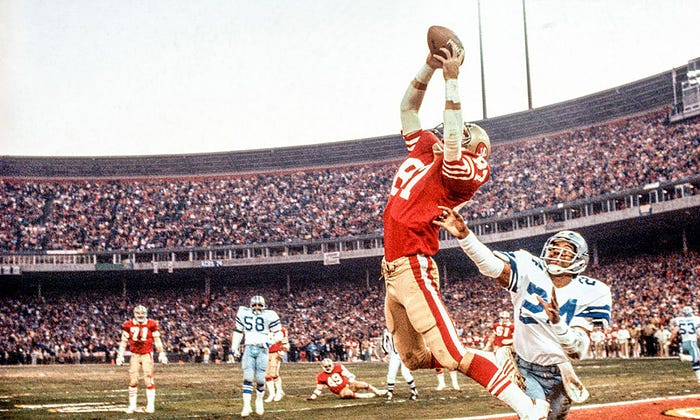Dwight Clark Was More Than “The Catch.” But “The Catch” Was Always Something More.

Yesterday Dwight Clark became the fourth player in San Francisco 49ers history to die from ALS. He was 61.
Everyone is focusing on “The Catch,” which defined the NFL of the 1980s.
But they are failing to recognize an otherwise stellar football career both on and off the field.
Witness at Clemson, his 62-yard touchdown reception against Maryland in 1978 gave the Tigers their first ACC Championship in 11 years. In many ways this paved the way for the success of Clemson under Danny Ford for years to come, much like Clark’s game-winning touchdown against the Dallas Cowboys in the ’81 NFC Championship Game paved the way for the Niners’ dynasty.

Following the heroics of “The Catch,” Clark led the NFL in receptions the following season. Though he would be overshadowed by Jerry Rice in future seasons, one might say the same for every other receiver who ever played football.
In all, Clark finished with more than 500 receptions and a real place in football lore.
Clark moved to the front office of the 49ers following his career. Eventually advancing to become San Francisco’s general manager during a memorable 12–4 season in 1998, he was part of an organization that won three more Super Bowls and continued to win until, well, he left to become the general manager of the upstart Cleveland Browns in 1999.
Clark would continue in this position until 2002, when the Browns made their only trip to the playoffs after being revived. Head coach Butch Jones wanted to take over more personnel decisions, and so Clark resigned.
Cleveland hasn’t been back to the playoffs since.
But it’s going to be “The Catch” Clark’s remembered for. Yes, one can discuss whether that won the NFC Championship for the Niners or if Danny White fumbled it to them in the following drive.
But it marked the start of the 49ers dynasty, just as “The Immaculate Reception” marked the start of the Steelers dynasty.
I’m a child of the ’80s. The 1981 season was the first I followed from start to finish religiously, and one could see the 49ers dynasty taking shape that year.
They had even defeated the Steelers- Montana against Bradshaw- in Pittsburgh that season and demolished the Cowboys early in the season.
Some writers scoffed. That 45–14 victory against the Cowboys early in the season had to be a fluke.
The NFC Championship Game was where America’s Team would triumph. Tom Landry had done it 10 years before to San Francisco, beating the 49ers in three straight seasons in the playoffs. This was just the fifth time the 49ers had ever made the NFL playoffs in 32 seasons.
Dallas, who was coming off a 38–0 playoff victory, was favored by three points.
But I was growing up and so were the 49ers. This was a very likeable team with Joe Montana and enough proud veterans; Ray Wershing, Hacksaw Reynolds, Freddie Soloman, who had played so well for so long but had never enjoyed the fruits of their labor.
Meanwhile, I always viewed the Cowboys as arrogant. How were they America’s Team when they always lost to the Steelers? On Monday Night Football Howard Cosell was intelligent and Don Meredith was corny and seemingly unprepared.
On a personal note, my mother and I had moved from Pittsburgh to a small town called Huntingdon, Pennsylvania where she would teach at Juniata College the year before. And even at my young age there was a culture shock, one of which being not everyone in town rooted for the Steelers.
Mind you, I could figure out pulling for the Philadelphia Eagles in Central Pennsylvania, though I did not agree.
But how do you pull for the Dallas Cowboys in Huntingdon, Pennsylvania?
But the story line of this game; the frisky young colt of Joe Montana and the 49ers playing the established standard was so captivating that my grandfather, not the biggest sports fan in the world, actually watched this game instead of traveling to build his retirement home in the North Carolina mountains, which he did almost every weekend. What could be bigger?
So here’s Dallas up 27–21 late in the game. Five minutes left. Held just shy of advancing into field goal range that would put the game away, the Cowboys punt. Solomon fields the ball and falls on his rump at his own 11.
I remember clapping my hands. “Here we go! Montana can do it!”
And he did! Twice converting on third down in the process of taking the ball to the Cowboys six-yard-line. Throwing to his wide receivers, not just dinking and dunking to the backs. Even a reverse with Solomon.
Linville Elliott, a nondescript running back who somehow didn’t get the attention Bill Ring did in the 49ers backfield, had just picked up seven yards to advance the ball to the Cowboys six yard line for a 3rd and 3 with 58 seconds left and one time out. I remember thinking 49ers head coach Bill Walsh would call another running play as he had done previously.
But they didn’t. Oh no.
Montana is being rushed by D.D. Lewis, Too Tall Jones, and Larry Bethea as he rolls to his right! Nobody’s open! OH NO!
He’s throwing the ball away! Off his back foot! Jones is leaping to the sky to knock down the pass! Montana can’t possibly see what’s in front of him! OH GOD NO!
And then Dwight Clark, who wasn’t even supposed to be running in the direction he was, beats Everson Walls, who was up for the Hall of Fame last January, by leaping to the moon and catching this ball with his mitts and keeping his feet in bounds!

Oh, YES!
There was even a cherry on top; the ensuing crowd shot on television captured one lonely Cowboys fan in a white coat showing her dismay among a sea of San Franciscans going crazy as only San Franciscans can!
That was it! Montana’s on the next cover of Time. Two weeks later in the Super Bowl Alcoa’s Fantastic Finishes relieves the play- proof Clark had instantly become iconic.
Meanwhile the Children of the ’80s wishing to sell out their hometowns now pulled for the 49ers, not the Cowboys. A torch had passed.
There have been memorable plays since then; Home Run Throwback, David Tyree catching a ball off his helmet, Tony Dorsett running 99 yards for a touchdown.
There have been great drives; Elway to beat the Browns, Montana to win Super Bowl XXIII, Roethlisberger to Santonio Holmes to win Super Bowl LXIII.
There have been great dynasties; the Cowboys of the ’90s. The Patriots of this Century. Teams like the Redskins, Steelers, Giants, Packers and Broncos sneaking in just enough in the interim to make it interesting.
But don’t you see? Dwight Clark was the innovator. His leap mixed all those elements together.
And even if you want to argue “The Immaculate Reception” begat “The Catch,” plays so great, dramatic, unexpected and inspiring one doesn’t even have to be reminded of the players or situations; the ’72 Steelers didn’t go on to win the Super Bowl.
The ’81 Niners did.
Subscribe to Marky Billson’s Rumble page!
